The Cambridge History of Japan, Vol. 4: Early Modern Japan
Подождите немного. Документ загружается.

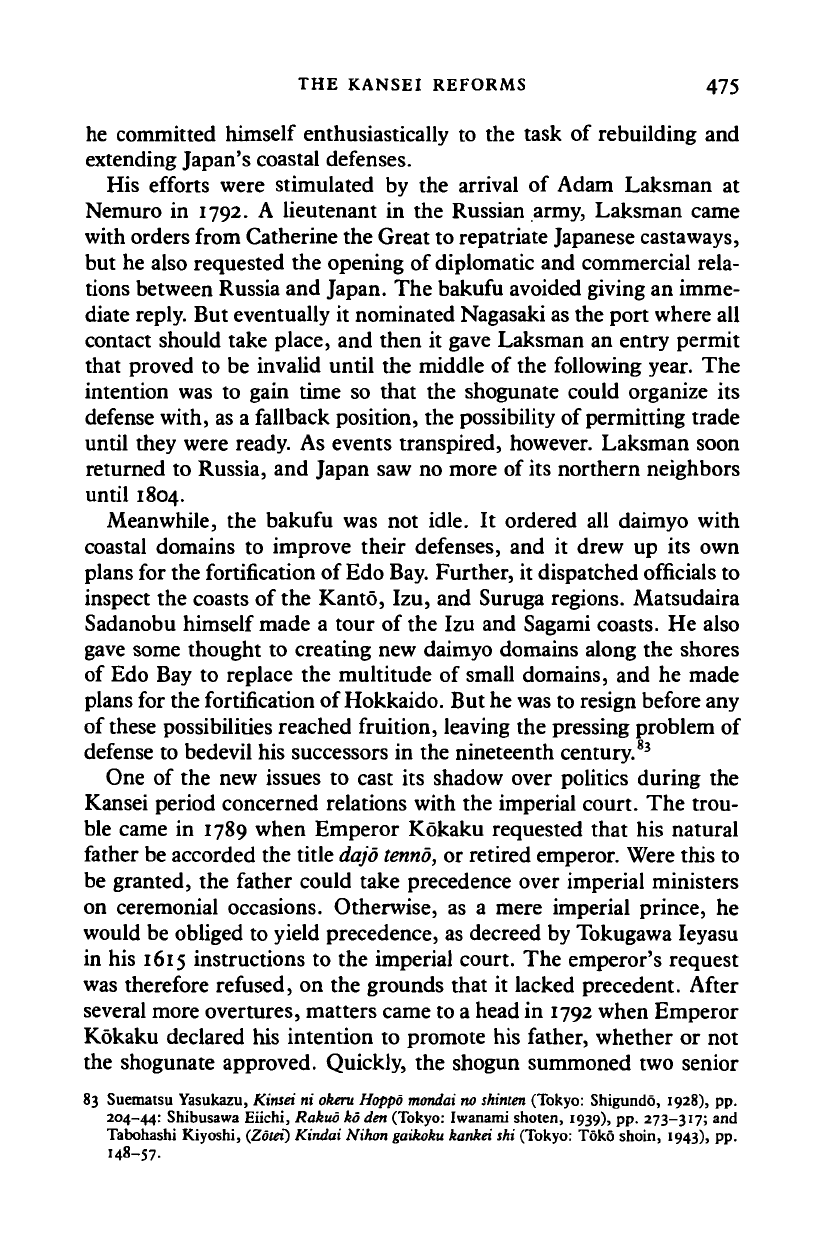
THE KANSEI REFORMS 475
he committed himself enthusiastically to the task of rebuilding and
extending Japan's coastal defenses.
His efforts were stimulated by the arrival of Adam Laksman at
Nemuro in 1792. A lieutenant in the Russian army, Laksman came
with orders from Catherine the Great to repatriate Japanese castaways,
but he also requested the opening of diplomatic and commercial rela-
tions between Russia and Japan. The bakufu avoided giving an imme-
diate reply. But eventually it nominated Nagasaki as the port where all
contact should take place, and then it gave Laksman an entry permit
that proved to be invalid until the middle of the following year. The
intention was to gain time so that the shogunate could organize its
defense with, as a fallback position, the possibility of permitting trade
until they were ready. As events transpired, however. Laksman soon
returned to Russia, and Japan saw no more of its northern neighbors
until 1804.
Meanwhile, the bakufu was not idle. It ordered all daimyo with
coastal domains to improve their defenses, and it drew up its own
plans for the fortification of
Edo
Bay.
Further, it dispatched officials to
inspect the coasts of the Kanto, Izu, and Suruga regions. Matsudaira
Sadanobu himself made a tour of the Izu and Sagami coasts. He also
gave some thought to creating new daimyo domains along the shores
of Edo Bay to replace the multitude of small domains, and he made
plans for the fortification of Hokkaido. But he was to resign before any
of these possibilities reached fruition, leaving the pressing problem of
defense to bedevil his successors in the nineteenth century.
83
One of the new issues to cast its shadow over politics during the
Kansei period concerned relations with the imperial court. The trou-
ble came in 1789 when Emperor Kokaku requested that his natural
father be accorded the title
dajo
tenno,
or retired emperor. Were this to
be granted, the father could take precedence over imperial ministers
on ceremonial occasions. Otherwise, as a mere imperial prince, he
would be obliged to yield precedence, as decreed by Tokugawa Ieyasu
in his 1615 instructions to the imperial court. The emperor's request
was therefore refused, on the grounds that it lacked precedent. After
several more overtures, matters came to a head in 1792 when Emperor
Kokaku declared his intention to promote his father, whether or not
the shogunate approved. Quickly, the shogun summoned two senior
83 Suematsu Yasukazu, Kinsei ni okeru Hoppo numdai no
shinien
(Tokyo: Shigundo, 1928), pp.
204-44:
Shibusawa Eiichi, Rakud ko den (Tokyo: Iwanami shoten, 1939), pp. 273-317; and
Tabohashi Kiyoshi, (Zotei) Kindai Nihtm gaikoku kankei shi (Tokyo: Toko shoin, 1943), pp.
148-57.
Cambridge Histories Online © Cambridge University Press, 2008

476 POLITICS
IN THE
EIGHTEENTH CENTURY
court officials
to Edo and the
following year punished them
for
their
role
in the
incident.
Unfortunately
for
Kokaku
and his
father, they
had
chosen
the
least
opportune time
to
approach
the
shogunate with such
a
request.
By
coincidence, Matsudaira Sadanobu was already committed
to
resisting
a similar initiative from the shogun Ienari, who
had
expressed the wish
that his own father, Hitotsubashi Harusada, might be given
the
title of
retired shogun (completely unwarranted,
for he was no
such thing).
Although Sadanobu owed
a
great deal
to the
head
of
the Hitotsubashi
branch, including
his own
promotion
to
senior councilor
and
subse-
quently
to
shogunal guardian,
his
debt was
not
so heavy that he would
countenance quite such
a
promotion. Were
it to
eventuate, Hitotsu-
bashi might very well become
so
strong
as to
threaten
the
political
supremacy
of the
shogun's
own
cabinet
of
advisers.
Were
the
govern-
ment
to
accede
to the
emperor's request,
the
same privilege could
hardly
be
refused
to the
shogun.
84
The
punishment
of the
Kyoto
envoys
in
1790 laid both issues
to
rest,
but it
left
an
open sore between
Kyoto
and Edo.
There
is no
doubt that
by
this time Matsudaira Sadanobu
had be-
come generally unpopular. When
he
announced
his
intention
to
resign
in 1791,
a
move designed, perhaps,
to
gauge
the
depth
of
his
support,
his followers prevailed
on
him
to
remain
in
office.
The
following year,
he tested
his
standing
a
second time. After learning that several ladies-
in-waiting
had
become involved with Buddhist priests, Sadanobu insti-
gated a purge of the shogunal women's quarters. Then, feeling vulnera-
ble,
he
formally requested permission
to
surrender some
of
his
duties.
In particular
he
asked
to be
relieved
of his
financial responsibilities
within
the
bakufu,
his
supervision
of
the shogun's household,
and his
position
as
shogunal guardian. Once again
he was
reassured.
The
shogun relieved
him
only
of his
duties
as
supervisor
of the
shogunal
household, confirming Sadanobu
in
everything else
and
showering
him with gifts.
In 1793,
however, Sadanobu decided
to
test Ienari's
confidence
in him for the
third,
and to his
surprise,
the
last time.
Asking
to be
relieved
of
his
duties
as
shogunal guardian,
he
found
his
request granted
- and was
stripped
of his
office
of
senior councilor
into
the
bargain.
85
In
the
short term, Sadanobu's departure made little difference
to
the general thrust
of
government policy.
His
office passed
to
his friend
84 Tsuji Zennosuke, Nihon
bunkasht
(Tokyo: Shunjusha, 1950), vol. pp. 138-327. The Kyoto
affair is referred to as the
songo
(title) incident.
85 Shibusawa, Rakud ko den, pp. 318-33.
Cambridge Histories Online © Cambridge University Press, 2008
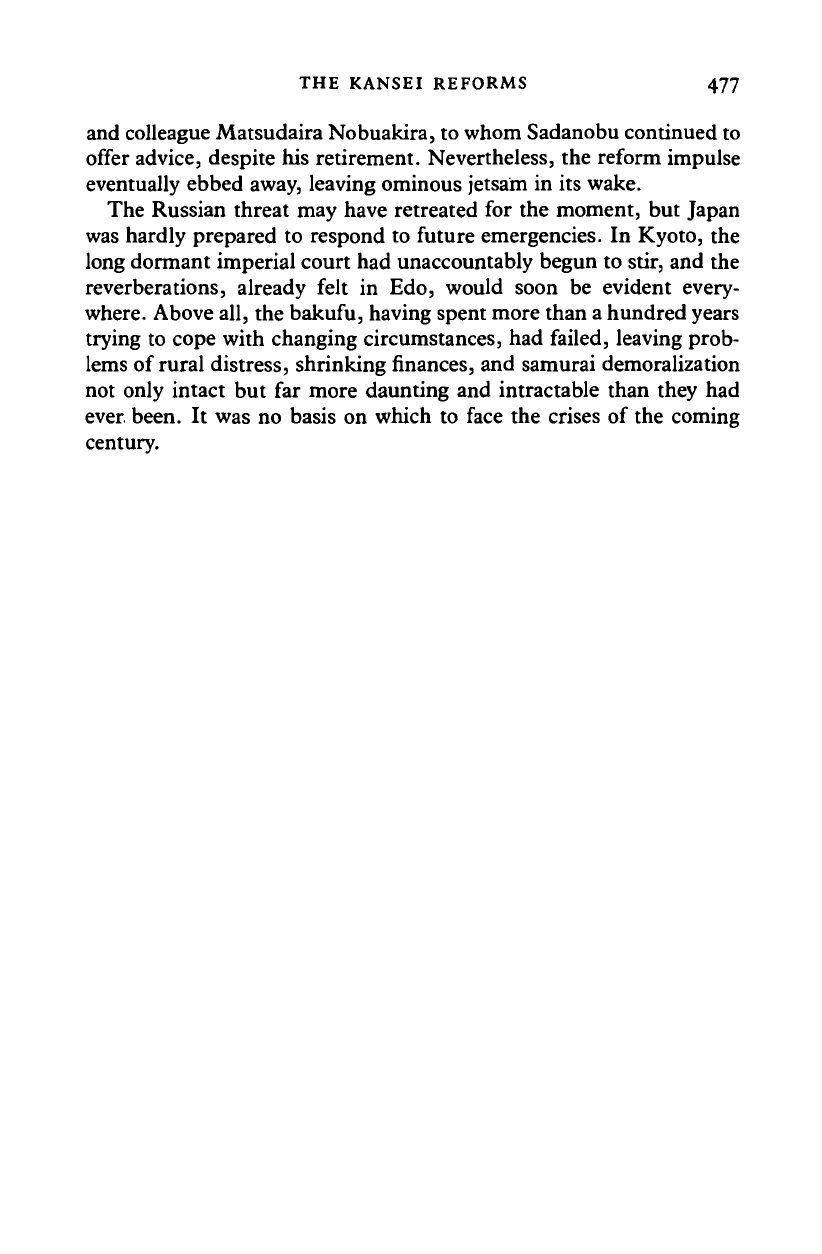
THE KANSEI REFORMS 477
and colleague Matsudaira Nobuakira, to whom Sadanobu continued to
offer advice, despite his retirement. Nevertheless, the reform impulse
eventually ebbed away, leaving ominous jetsam in its wake.
The Russian threat may have retreated for the moment, but Japan
was hardly prepared to respond to future emergencies. In Kyoto, the
long dormant imperial court had unaccountably begun to stir, and the
reverberations, already felt in Edo, would soon be evident every-
where. Above all, the bakufu, having spent more than a hundred years
trying to cope with changing circumstances, had failed, leaving prob-
lems of rural distress, shrinking finances, and samurai demoralization
not only intact but far more daunting and intractable than they had
ever. been. It was no basis on which to face the crises of the coming
century.
Cambridge Histories Online © Cambridge University Press, 2008
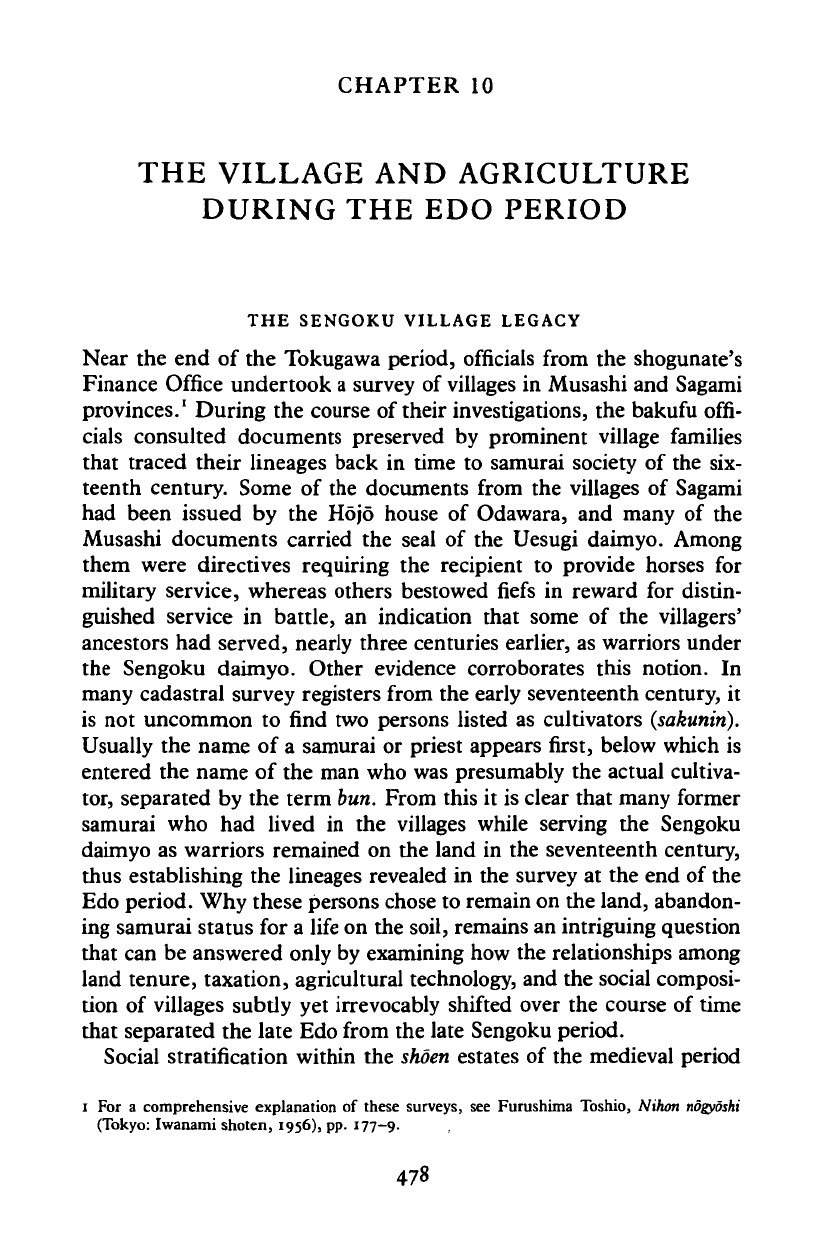
CHAPTER
10
THE VILLAGE AND AGRICULTURE
DURING THE EDO PERIOD
THE SENGOKU VILLAGE LEGACY
Near the end of the Tokugawa period, officials from the shogunate's
Finance Office undertook a survey of villages in Musashi and Sagami
provinces.
1
During the course of their investigations, the bakufu offi-
cials consulted documents preserved by prominent village families
that traced their lineages back in time to samurai society of the six-
teenth century. Some of the documents from the villages of Sagami
had been issued by the Ho jo house of Odawara, and many of the
Musashi documents carried the seal of the Uesugi daimyo. Among
them were directives requiring the recipient to provide horses for
military service, whereas others bestowed fiefs in reward for distin-
guished service in battle, an indication that some of the villagers'
ancestors had served, nearly three centuries earlier, as warriors under
the Sengoku daimyo. Other evidence corroborates this notion. In
many cadastral survey registers from the early seventeenth century, it
is not uncommon to find two persons listed as cultivators (sakunin).
Usually the name of a samurai or priest appears first, below which is
entered the name of the man who was presumably the actual cultiva-
tor, separated by the term
bun.
From this it is clear that many former
samurai who had lived in the villages while serving the Sengoku
daimyo as warriors remained on the land in the seventeenth century,
thus establishing the lineages revealed in the survey at the end of the
Edo period. Why these persons chose to remain on the land, abandon-
ing samurai status for a life on the soil, remains an intriguing question
that can be answered only by examining how the relationships among
land tenure, taxation, agricultural technology, and the social composi-
tion of villages subtly yet irrevocably shifted over the course of time
that separated the late Edo from the late Sengoku period.
Social stratification within the
shoen
estates of the medieval period
i For a comprehensive explanation of these surveys, see Furushima Toshio, Nihon
nogyoshi
(Tokyo: Iwanami shoten, 1956), pp. 177-9.
478
Cambridge Histories Online © Cambridge University Press, 2008
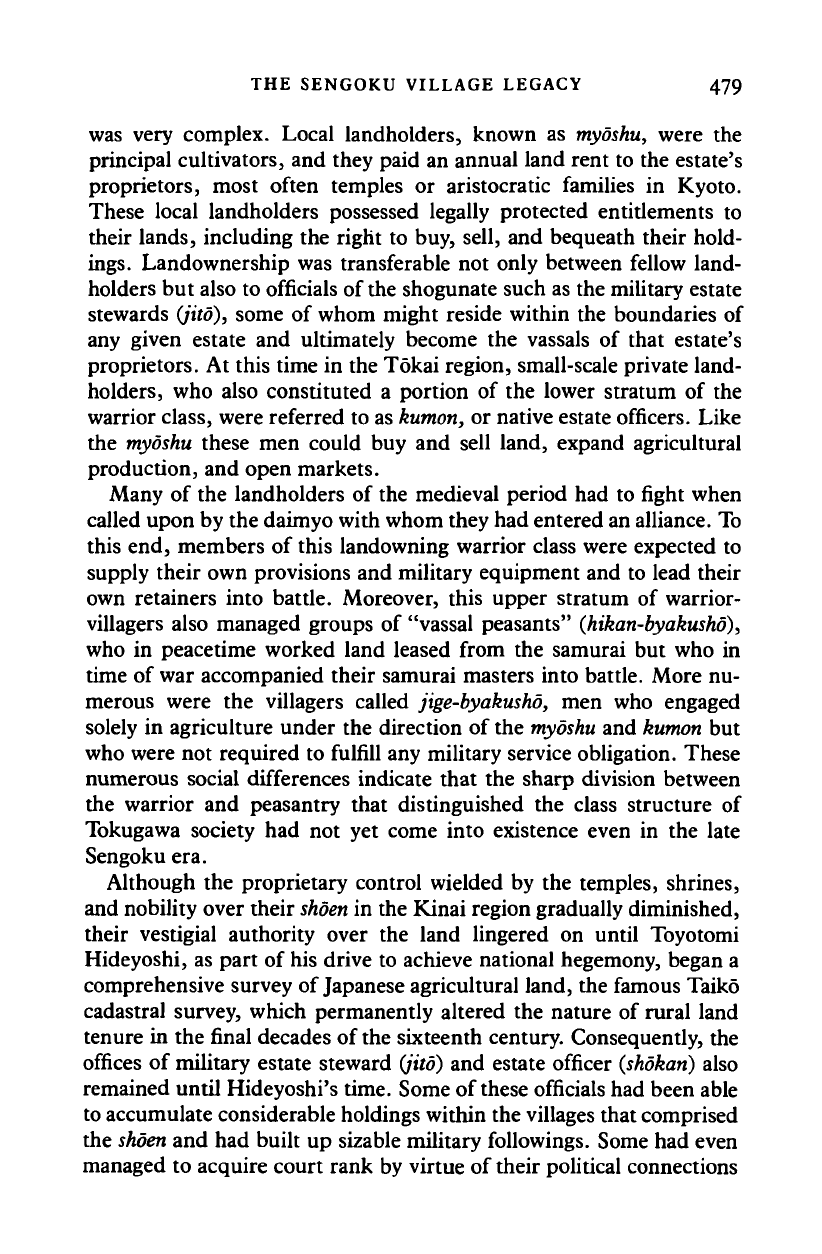
THE SENGOKU VILLAGE LEGACY 479
was very complex. Local landholders, known as
myoshu,
were the
principal cultivators, and they paid an annual land rent to the estate's
proprietors, most often temples or aristocratic families in Kyoto.
These local landholders possessed legally protected entitlements to
their lands, including the right to buy, sell, and bequeath their hold-
ings.
Landownership was transferable not only between fellow land-
holders but also to officials of
the
shogunate such as the military estate
stewards (jito), some of whom might reside within the boundaries of
any given estate and ultimately become the vassals of that estate's
proprietors. At this time in the Tokai region, small-scale private land-
holders, who also constituted a portion of the lower stratum of the
warrior class, were referred to as
kumon,
or native estate officers. Like
the
myoshu
these men could buy and sell land, expand agricultural
production, and open markets.
Many of the landholders of the medieval period had to fight when
called upon by the daimyo with whom they had entered an alliance. To
this end, members of this landowning warrior class were expected to
supply their own provisions and military equipment and to lead their
own retainers into battle. Moreover, this upper stratum of warrior-
villagers also managed groups of "vassal peasants"
(hikan-byakusho),
who in peacetime worked land leased from the samurai but who in
time of war accompanied their samurai masters into battle. More nu-
merous were the villagers called
jige-byakusho,
men who engaged
solely in agriculture under the direction of the
myoshu
and
kumon
but
who were not required to fulfill any military service obligation. These
numerous social differences indicate that the sharp division between
the warrior and peasantry that distinguished the class structure of
Tokugawa society had not yet come into existence even in the late
Sengoku era.
Although the proprietary control wielded by the temples, shrines,
and nobility over their
shden
in the Kinai region gradually diminished,
their vestigial authority over the land lingered on until Toyotomi
Hideyoshi, as part of his drive to achieve national hegemony, began a
comprehensive survey of Japanese agricultural land, the famous Taiko
cadastral survey, which permanently altered the nature of rural land
tenure in the final decades of the sixteenth century. Consequently, the
offices of military estate steward
(jito)
and estate officer
(shokan)
also
remained until Hideyoshi's time. Some of these officials had been able
to accumulate considerable holdings within the villages that comprised
the
shden
and had built up sizable military followings. Some had even
managed to acquire court rank by virtue of their political connections
Cambridge Histories Online © Cambridge University Press, 2008
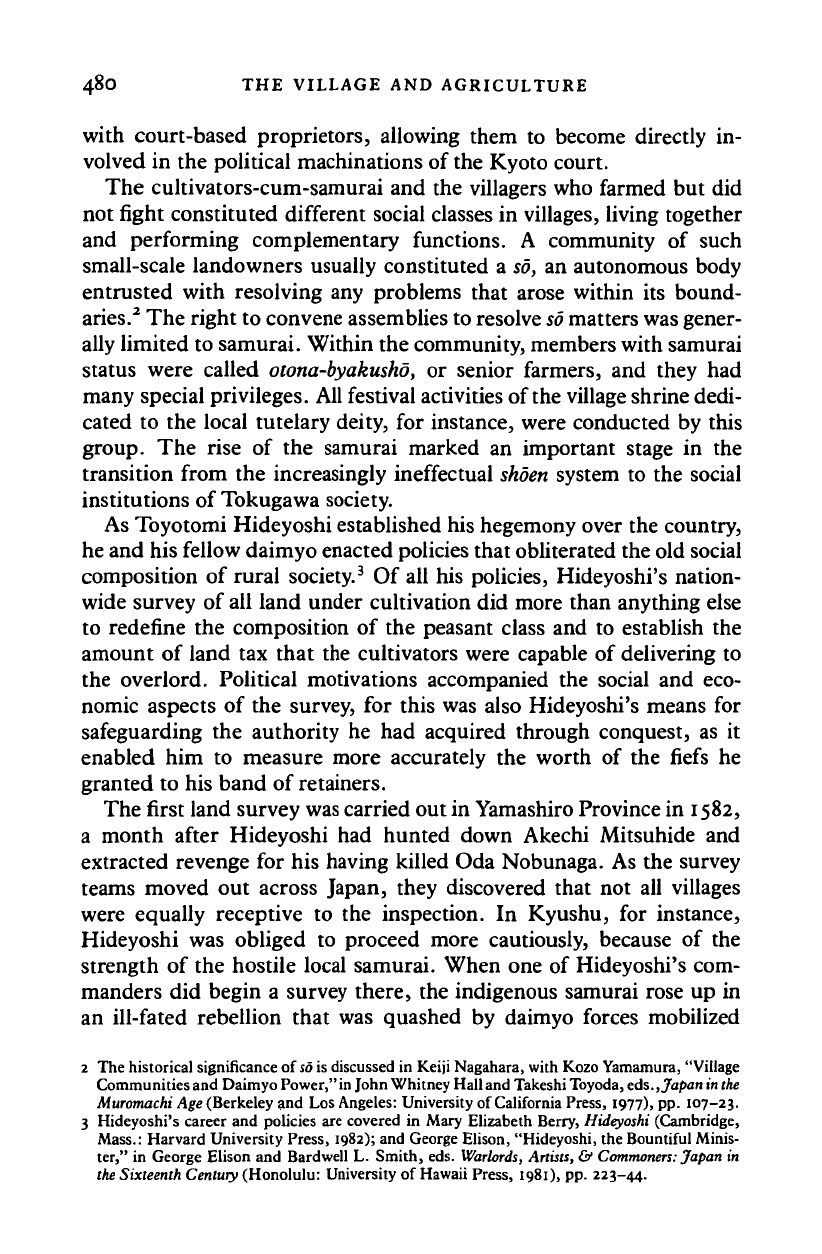
480 THE VILLAGE AND AGRICULTURE
with court-based proprietors, allowing them to become directly in-
volved in the political machinations of the Kyoto court.
The cultivators-cum-samurai and the villagers who farmed but did
not fight constituted different social classes in villages, living together
and performing complementary functions. A community of such
small-scale landowners usually constituted a
so,
an autonomous body
entrusted with resolving any problems that arose within its bound-
aries.
2
The right to convene assemblies to resolve
so
matters was gener-
ally limited to samurai. Within the community, members with samurai
status were called
otona-byakusho,
or senior farmers, and they had
many special privileges. All festival activities of the village shrine dedi-
cated to the local tutelary deity, for instance, were conducted by this
group. The rise of the samurai marked an important stage in the
transition from the increasingly ineffectual
shoen
system to the social
institutions of Tokugawa society.
As Toyotomi Hideyoshi established his hegemony over the country,
he and his fellow daimyo enacted policies that obliterated the old social
composition of rural society.
3
Of all his policies, Hideyoshi's nation-
wide survey of all land under cultivation did more than anything else
to redefine the composition of the peasant class and to establish the
amount of land tax that the cultivators were capable of delivering to
the overlord. Political motivations accompanied the social and eco-
nomic aspects of the survey, for this was also Hideyoshi's means for
safeguarding the authority he had acquired through conquest, as it
enabled him to measure more accurately the worth of the fiefs he
granted to his band of retainers.
The first land survey was carried out in Yamashiro Province in 1582,
a month after Hideyoshi had hunted down Akechi Mitsuhide and
extracted revenge for his having killed Oda Nobunaga. As the survey
teams moved out across Japan, they discovered that not all villages
were equally receptive to the inspection. In Kyushu, for instance,
Hideyoshi was obliged to proceed more cautiously, because of the
strength of the hostile local samurai. When one of Hideyoshi's com-
manders did begin a survey there, the indigenous samurai rose up in
an ill-fated rebellion that was quashed by daimyo forces mobilized
2 The historical significance of
so
is discussed in Keiji Nagahara, with Kozo Yamamura, "Village
Communities and Daimyo
Power,"
in
John Whitney Hall and Takeshi Toyoda,
eds.,
Japan
in the
Muromachi
Age (Berkeley and Los Angeles: University of California Press, 1977), pp. 107-23.
3 Hideyoshi's career and policies are covered in Mary Elizabeth Berry, Hideyoshi (Cambridge,
Mass.:
Harvard University Press, 1982); and George Elison, "Hideyoshi, the Bountiful Minis-
ter," in George Elison and Bardwell L. Smith, eds.
Warlords,
Artists, &
Commoners:
Japan in
the
Sixteenth Century (Honolulu: University of Hawaii Press, 1981), pp. 223-44.
Cambridge Histories Online © Cambridge University Press, 2008
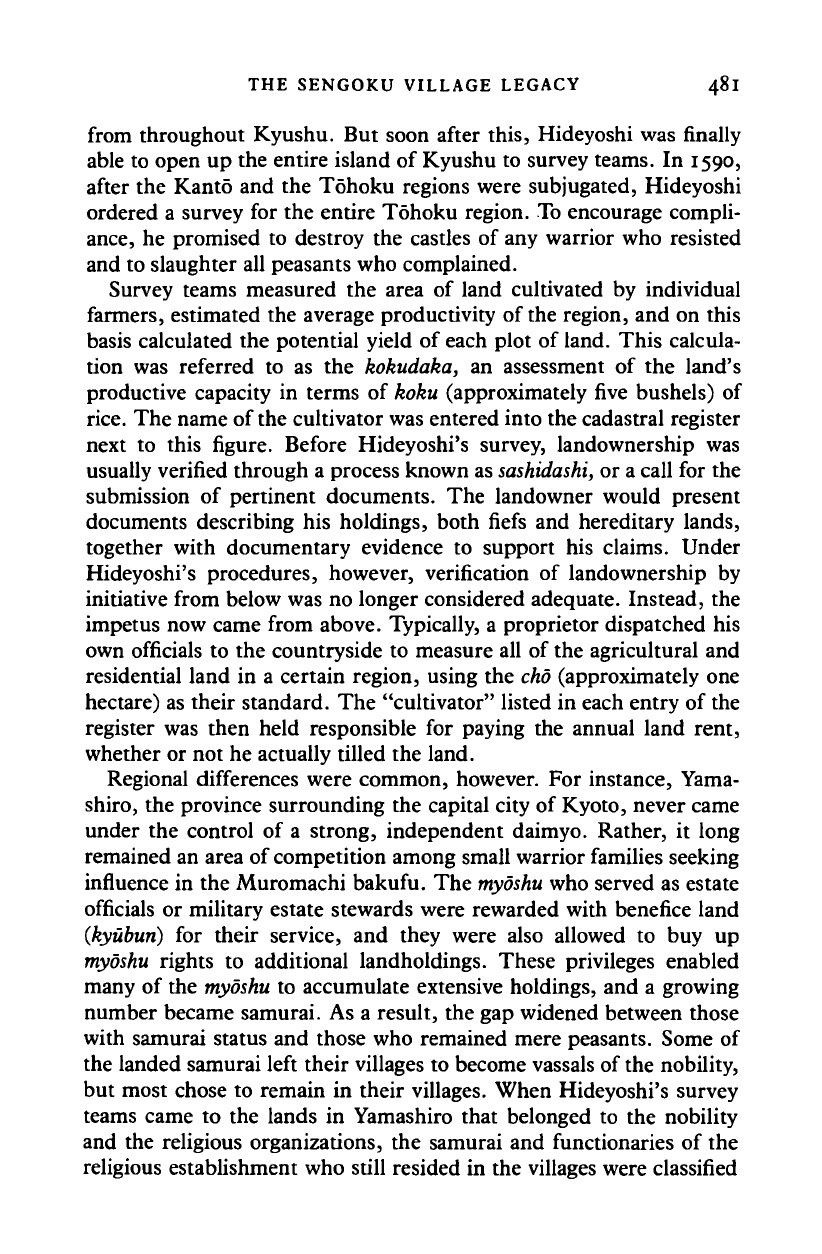
THE SENGOKU VILLAGE LEGACY 481
from throughout Kyushu. But soon after this, Hideyoshi was finally
able to open up the entire island of Kyushu to survey teams. In 1590,
after the Kanto and the Tohoku regions were subjugated, Hideyoshi
ordered a survey for the entire Tohoku region. To encourage compli-
ance,
he promised to destroy the castles of any warrior who resisted
and to slaughter all peasants who complained.
Survey teams measured the area of land cultivated by individual
farmers, estimated the average productivity of the region, and on this
basis calculated the potential yield of each plot of land. This calcula-
tion was referred to as the kokudaka, an assessment of the land's
productive capacity in terms of koku (approximately five bushels) of
rice.
The name of the cultivator was entered into the cadastral register
next to this figure. Before Hideyoshi's survey, landownership was
usually verified through a process known as
sashidashi,
or a call for the
submission of pertinent documents. The landowner would present
documents describing his holdings, both fiefs and hereditary lands,
together with documentary evidence to support his claims. Under
Hideyoshi's procedures, however, verification of landownership by
initiative from below was no longer considered adequate. Instead, the
impetus now came from above. Typically, a proprietor dispatched his
own officials to the countryside to measure all of the agricultural and
residential land in a certain region, using the
cho
(approximately one
hectare) as their standard. The "cultivator" listed in each entry of the
register was then held responsible for paying the annual land rent,
whether or not he actually tilled the land.
Regional differences were common, however. For instance, Yama-
shiro,
the province surrounding the capital city of Kyoto, never came
under the control of a strong, independent daimyo. Rather, it long
remained an area of competition among small warrior families seeking
influence in the Muromachi bakufu. The
myoshu
who served as estate
officials or military estate stewards were rewarded with benefice land
(kyubun) for their service, and they were also allowed to buy up
myoshu
rights to additional landholdings. These privileges enabled
many of the
myoshu
to accumulate extensive holdings, and a growing
number became samurai. As a result, the gap widened between those
with samurai status and those who remained mere peasants. Some of
the landed samurai left their villages to become vassals of the nobility,
but most chose to remain in their villages. When Hideyoshi's survey
teams came to the lands in Yamashiro that belonged to the nobility
and the religious organizations, the samurai and functionaries of the
religious establishment who still resided in the villages were classified
Cambridge Histories Online © Cambridge University Press, 2008
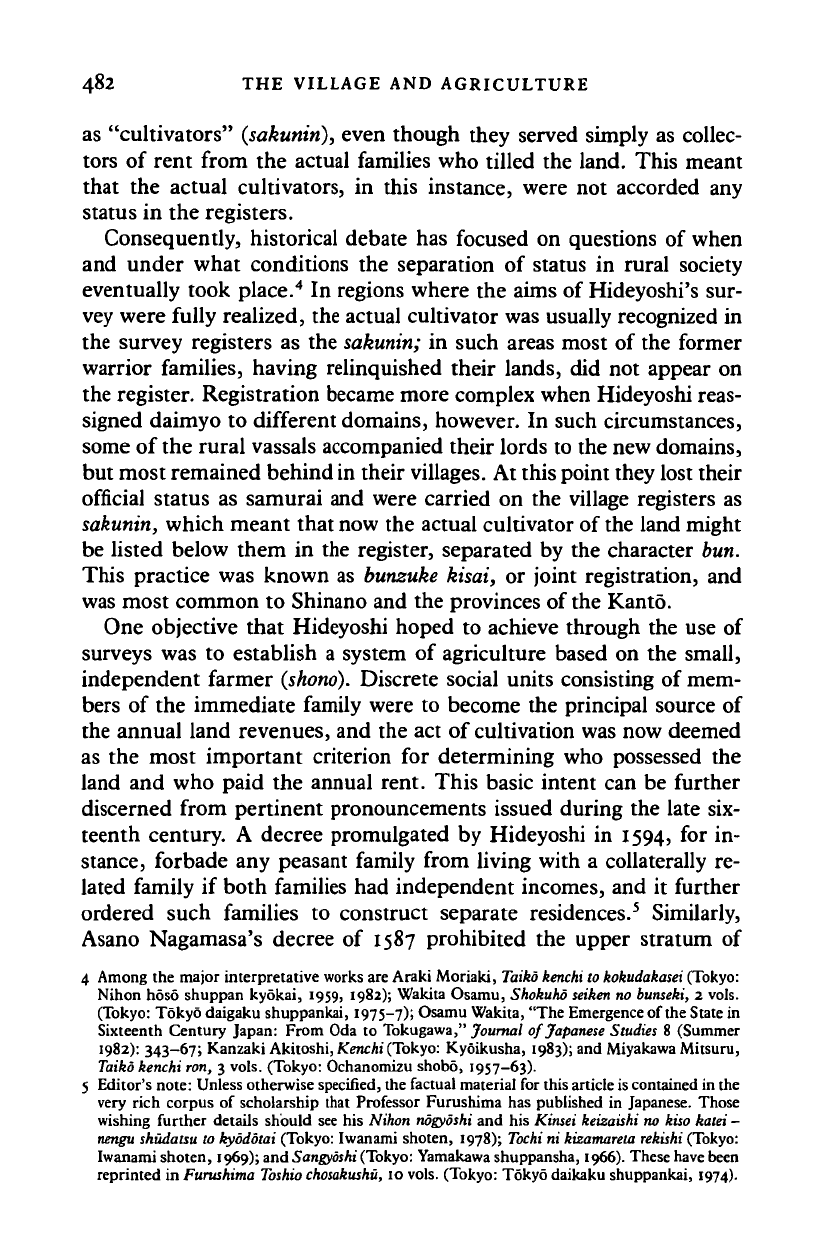
482 THE VILLAGE AND AGRICULTURE
as "cultivators" (sakunin), even though they served simply as collec-
tors of rent from the actual families who tilled the land. This meant
that the actual cultivators, in this instance, were not accorded any
status in the registers.
Consequently, historical debate has focused on questions of when
and under what conditions the separation of status in rural society
eventually took place.
4
In regions where the aims of Hideyoshi's sur-
vey were fully realized, the actual cultivator was usually recognized in
the survey registers as the
sakunin;
in such areas most of the former
warrior families, having relinquished their lands, did not appear on
the register. Registration became more complex when Hideyoshi reas-
signed daimyo to different domains, however. In such circumstances,
some of the rural vassals accompanied their lords to the new domains,
but most remained behind in their villages. At this point they lost their
official status as samurai and were carried on the village registers as
sakunin, which meant that now the actual cultivator of the land might
be listed below them in the register, separated by the character bun.
This practice was known as bunzuke kisai, or joint registration, and
was most common to Shinano and the provinces of the Kanto.
One objective that Hideyoshi hoped to achieve through the use of
surveys was to establish a system of agriculture based on the small,
independent farmer
(shono).
Discrete social units consisting of mem-
bers of the immediate family were to become the principal source of
the annual land revenues, and the act of cultivation was now deemed
as the most important criterion for determining who possessed the
land and who paid the annual rent. This basic intent can be further
discerned from pertinent pronouncements issued during the late six-
teenth century. A decree promulgated by Hideyoshi in 1594, for in-
stance, forbade any peasant family from living with a collaterally re-
lated family if both families had independent incomes, and it further
ordered such families to construct separate residences.
5
Similarly,
Asano Nagamasa's decree of 1587 prohibited the upper stratum of
4 Among the major interpretative works are Araki Moriaki, Taiko
kenchi
to
kokudakasei
(Tokyo:
Nihon hoso shuppan kyokai, 1959, 1982); Wakita Osamu, Shokuho
seiken
no bunseki, 2 vols.
(Tokyo: Tokyo daigaku shuppankai, 1975-7); Osamu Wakita, "The Emergence of the State in
Sixteenth Century Japan: From Oda to Tokugawa," Journal of Japanese Studies 8 (Summer
1982):
343-67; Kanzaki Akitoshi, Kenchi
(Tokyo:
Kyoikusha, 1983); and Miyakawa Mitsuru,
Taiko
kenchi ron, 3 vols. (Tokyo: Ochanomizu shobo, 1957-63).
5 Editor's note: Unless otherwise specified, the factual material for this article is contained in the
very rich corpus of scholarship that Professor Furushima has published in Japanese. Those
wishing further details should see his Nihon
nogyoshi
and his Kinsei keizaishi no kiso kalei -
nengu
shudatsu to kyodotai (Tokyo: Iwanami shoten, 1978);
Tochi
ni kizamareta
rekishi
(Tokyo:
Iwanami shoten, 1969); and
Sangyoshi
(Tokyo:
Yamakawa shuppansha, 1966). These have been
reprinted in
Furushima Toshio
chosakushu,
10 vols. (Tokyo: Tokyo daikaku shuppankai, 1974).
Cambridge Histories Online © Cambridge University Press, 2008
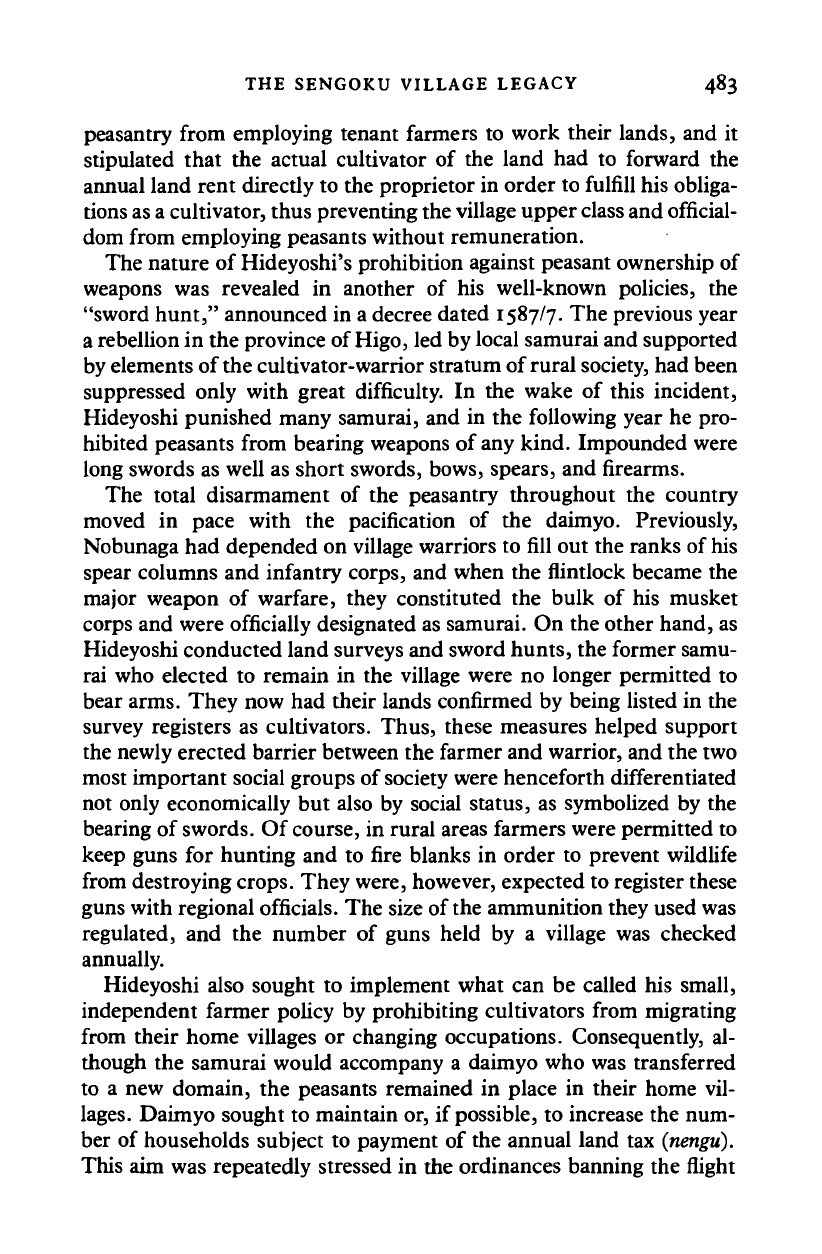
THE SENGOKU VILLAGE LEGACY 483
peasantry from employing tenant farmers to work their lands, and it
stipulated that the actual cultivator of the land had to forward the
annual land rent directly to the proprietor in order to fulfill his obliga-
tions as
a
cultivator, thus preventing the village upper
class
and official-
dom from employing peasants without remuneration.
The nature of Hideyoshi's prohibition against peasant ownership of
weapons was revealed in another of his well-known policies, the
"sword hunt," announced in a decree dated 1587/7. The previous year
a rebellion in the province of
Higo,
led by local samurai and supported
by elements of the cultivator-warrior stratum of rural society, had been
suppressed only with great difficulty. In the wake of this incident,
Hideyoshi punished many samurai, and in the following year he pro-
hibited peasants from bearing weapons of any kind. Impounded were
long swords as well as short swords, bows, spears, and firearms.
The total disarmament of the peasantry throughout the country
moved in pace with the pacification of the daimyo. Previously,
Nobunaga had depended on village warriors to fill out the ranks of his
spear columns and infantry corps, and when the flintlock became the
major weapon of warfare, they constituted the bulk of his musket
corps and were officially designated as samurai. On the other hand, as
Hideyoshi conducted land surveys and sword hunts, the former samu-
rai who elected to remain in the village were no longer permitted to
bear arms. They now had their lands confirmed by being listed in the
survey registers as cultivators. Thus, these measures helped support
the newly erected barrier between the farmer and warrior, and the two
most important social groups of society were henceforth differentiated
not only economically but also by social status, as symbolized by the
bearing of
swords.
Of
course,
in rural areas farmers were permitted to
keep guns for hunting and to fire blanks in order to prevent wildlife
from destroying crops. They were, however, expected to register these
guns with regional officials. The size of
the
ammunition they used was
regulated, and the number of guns held by a village was checked
annually.
Hideyoshi also sought to implement what can be called his small,
independent farmer policy by prohibiting cultivators from migrating
from their home villages or changing occupations. Consequently, al-
though the samurai would accompany a daimyo who was transferred
to a new domain, the peasants remained in place in their home vil-
lages.
Daimyo sought to maintain or, if
possible,
to increase the num-
ber of households subject to payment of the annual land tax
(nengu).
This aim was repeatedly stressed in the ordinances banning the flight
Cambridge Histories Online © Cambridge University Press, 2008
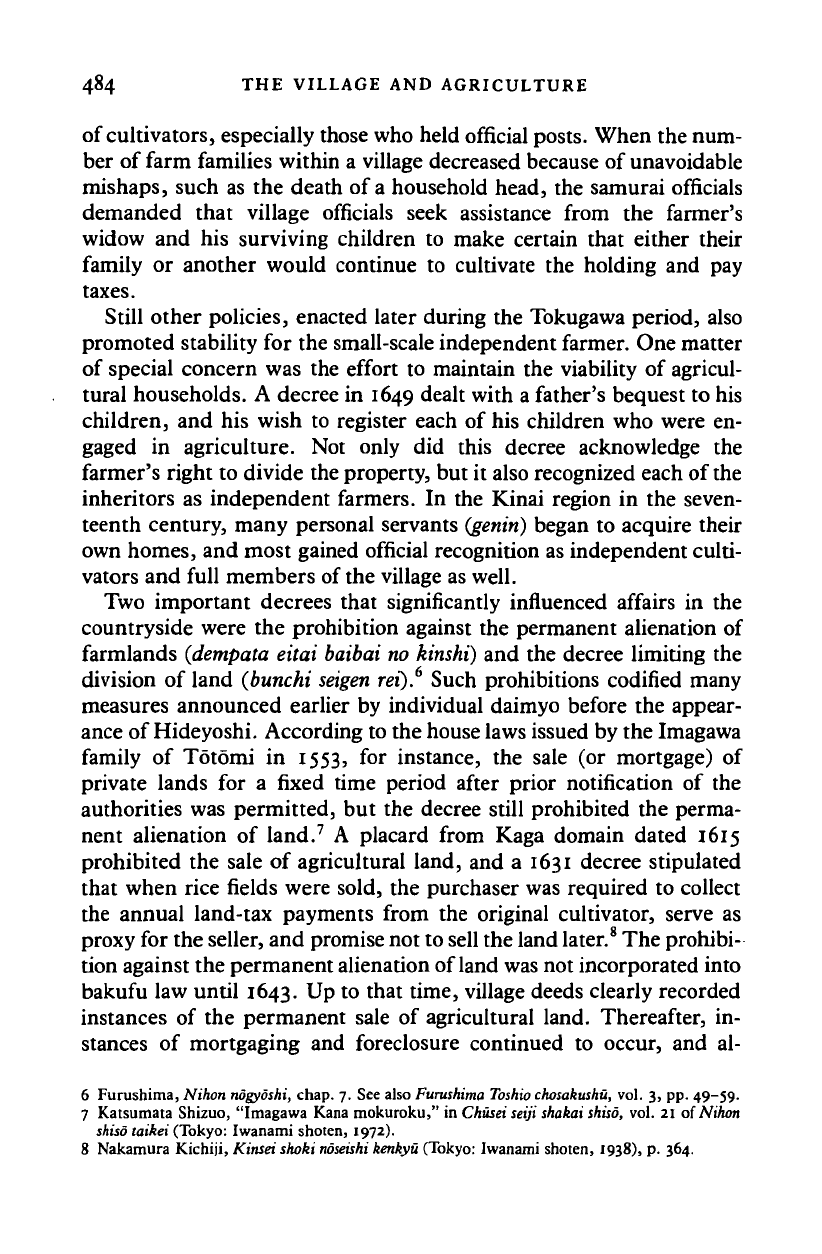
484 THE VILLAGE AND AGRICULTURE
of cultivators, especially those who held official posts. When the num-
ber of farm families within a village decreased because of unavoidable
mishaps, such as the death of
a
household head, the samurai officials
demanded that village officials seek assistance from the farmer's
widow and his surviving children to make certain that either their
family or another would continue to cultivate the holding and pay
taxes.
Still other policies, enacted later during the Tokugawa period, also
promoted stability for the small-scale independent farmer. One matter
of special concern was the effort to maintain the viability of agricul-
tural households. A decree in 1649 dealt with a father's bequest to his
children, and his wish to register each of his children who were en-
gaged in agriculture. Not only did this decree acknowledge the
farmer's right to divide the property, but it also recognized each of the
inheritors as independent farmers. In the Kinai region in the seven-
teenth century, many personal servants
(genin)
began to acquire their
own homes, and most gained official recognition as independent culti-
vators and full members of the village as well.
Two important decrees that significantly influenced affairs in the
countryside were the prohibition against the permanent alienation of
farmlands
(dempata
eitai
baibai
no
kinshi)
and the decree limiting the
division of land (bunchi
seigen
ret).
6
Such prohibitions codified many
measures announced earlier by individual daimyo before the appear-
ance of
Hideyoshi.
According to the house laws issued by the Imagawa
family of Totomi in 1553, for instance, the sale (or mortgage) of
private lands for a fixed time period after prior notification of the
authorities was permitted, but the decree still prohibited the perma-
nent alienation of land.
7
A placard from Kaga domain dated 1615
prohibited the sale of agricultural land, and a 1631 decree stipulated
that when rice fields were sold, the purchaser was required to collect
the annual land-tax payments from the original cultivator, serve as
proxy for the seller, and promise not to sell the land later.
8
The prohibi-
tion against the permanent alienation of land was not incorporated into
bakufu law until 1643. Up to that time, village deeds clearly recorded
instances of the permanent sale of agricultural land. Thereafter, in-
stances of mortgaging and foreclosure continued to occur, and al-
6 Furushima, Nihon nogyoshi, chap. 7. See also Furushima
Toshio
chosakushu, vol. 3, pp. 49-59.
7 Katsumata Shizuo, "Imagawa Kana mokuroku," in Chusei seiji shakai shiso, vol. 21 of Nihon
shiso laikei (Tokyo: Iwanami shoten, 1972).
8 Nakamura Kichiji, Kinsei shoki
ndseishi
kenkyu (Tokyo: Iwanami shoten, 1938), p. 364.
Cambridge Histories Online © Cambridge University Press, 2008
